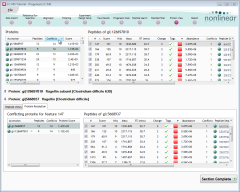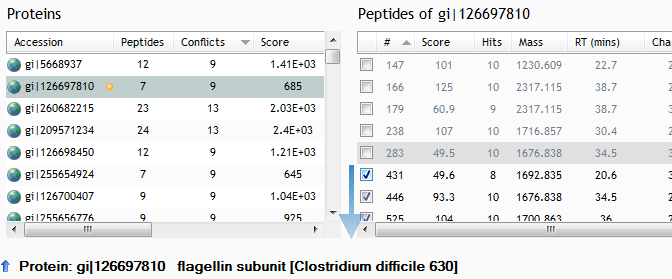Step 4. Identifying proteins
 When we searched for peptide identifications for our features, it's likely that some of our features were
matched to more than one peptide. Other features may have been assigned to the same peptide from
different proteins. These ambiguous peptide assignments are referred to as ‘conflicts’.
When we searched for peptide identifications for our features, it's likely that some of our features were
matched to more than one peptide. Other features may have been assigned to the same peptide from
different proteins. These ambiguous peptide assignments are referred to as ‘conflicts’.
To confidently identify our proteins, we need to resolve the ambiguity in our peptides' origins. The Protein View gives us the information we need to explore and resolve the conflicts.
Before we start, we'll focus the screen on the proteins with the most conflicts:
- Click the Protein Resolution tab in the lower half of the screen.
- Sort the Proteins table (top-left) on its Conflicts column by clicking the column header twice.
This will put the proteins with the most conflicting peptides at the top (see the image above).
Resolving a simple conflict
We'll start resolving our proteins with a simple example. To begin, click on the first protein in the Proteins list; it has the accession number gi|5668937. The list at the top-right of the screen updates to show us the 12 peptides from this protein that our peptide search found. The bold text below the list also shows us the description of the protein; in this case, it is flagellin [Clostridium difficile].

When we highlight each of these peptides by clicking on it, the lower half of the screen updates to show other proteins that include it i.e. the conflicts. If there are no conflicts, the lists in the bottom half of the screen remain empty.
Now, one at a time, click on each of the peptides in the top-right list. You will see that all 9 conflicts are due to the peptide appearing in one other protein: flagellin subunit [Clostridium difficile 630] (accession number gi|126697810). Given the known relationship between these two proteins, we can reject the ‘subunit’ identifications in favour of the main flagellin protein:
- In the Proteins list, select the flagellin subunit protein, accession number gi|126697810.
- Conveniently, all of the peptides in this protein are conflicts with those in the main flagellin protein; to reject the subunit peptides, simply untick all checkboxes in the top-right list.

When all peptides in the subunit protein have been unticked, you can see that the values in the Peptides and Conflicts columns have been reduced to zero. Equally importantly, the number of conflicts for the main flagellin protein is now also zero. The ambiguity has been resolved.
Interestingly, in this data, the next 2 proteins in the list show the same kind of conflicts i.e. they're related proteins. In such a case, it's often valid to favour the peptide identifications in the protein with the higher number of idenfitied peptides.
To complete the analysis, we would continue resolving peptide conflicts like this, one protein at a time. As well as recognising related proteins, we can use properties such as peptide identification score to help us decide which way a conflict should be resolved. We may even reject peptides from both proteins if the data is not decisive enough.
However, such a thorough analysis is beyond the scope of this tutorial. Instead, the following page summarises the analysis process and offers links to more in-depth guides for Progenesis LC‑MS…





